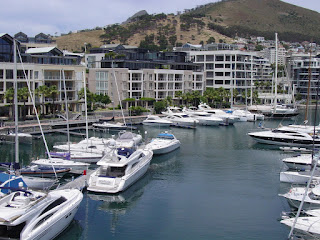Day Two in Africa was a surprise. We had no idea where we were going or what we were doing, just that we'd be taken around Cape Town. We start the day early and climb into a van/bus thingy and off we go. No clue where we're headed. It turns out, to my surprise and pleasure, we're beginning the day with Khayelitsha. Read the Wikipedia entry on Khayelitsha if want a better education than I can give, but essential in the 1950's the Apartheid government passed a law that forced everyone they classified as Black to move the hell out of the cities. All of the jobs were in the cities and the regime allowed Blacks to live on the outskirts of cities, and Khayelitsha was born.
People use terms like "shanty-town" and "township," but what it really is, in my opinion, is mass homelessness. Since the overthrow of Apartheid a lot has been done to improve living standards, but when you live in a temporary structure that barely keeps out the elements and you use a bucket for a toilet, that's homeless.
The first picture shows the difference between the improved housing and the temporary housing..
I was amazed to see that there are rows and rows of shipping containers used for business. I suppose it's the only way to have a secure building that you can lock at night. Whether a hair salon or an international corporation such as Vodaphone, they use shipping containers.
We visited Khayelitsha's first day care center. Finally some people, though obviously very few, can go to work and know that their children are safe. The center has a large garden where they are growing fresh food as well. It was one of two uplifting moments inside Khayelitsha.
I'll not belabor this with picture after picture of Khayelitsha living conditions. I never did get that shot where you can see shacks for miles, but I saw it. I believe it's important to understand that these things came about unnaturally for all who live there. They were forced, by the laws of their country, to abandon their homes. I can only hope that conditions improve and people are able to change their lives. It will happen, slowly.
There. Four pictures of Khayelitsha. Could have been 20. You would not believe where we went next.








